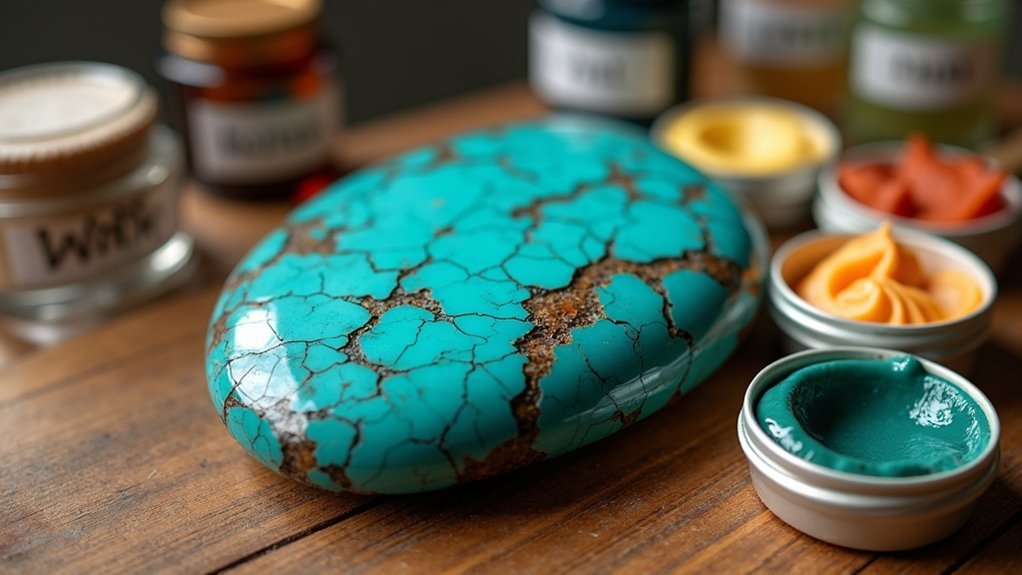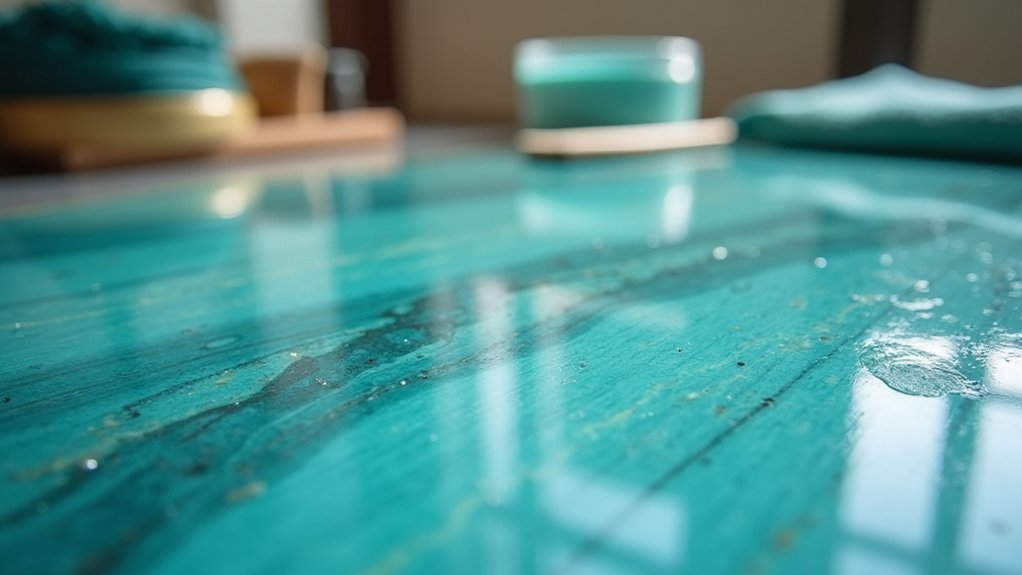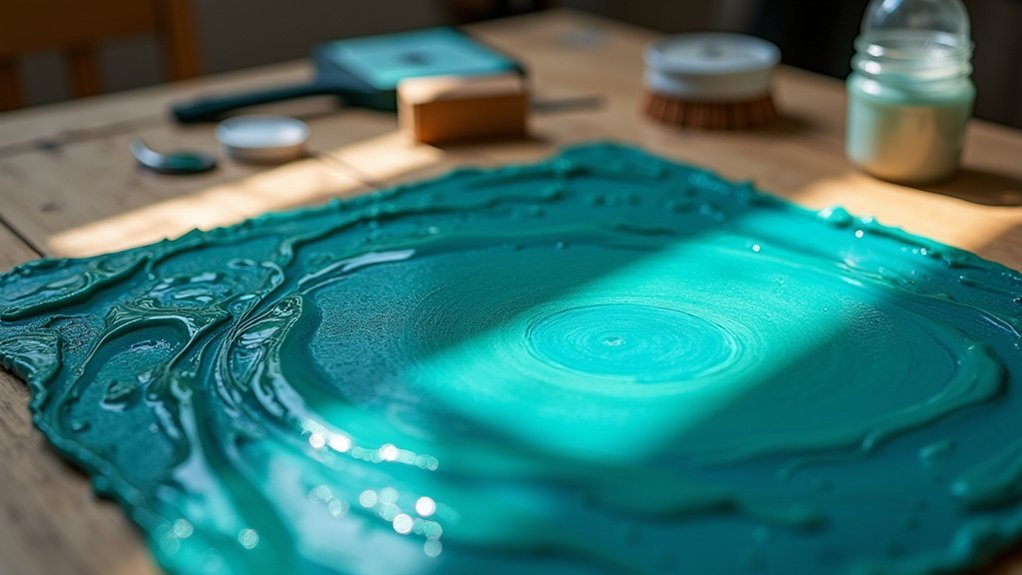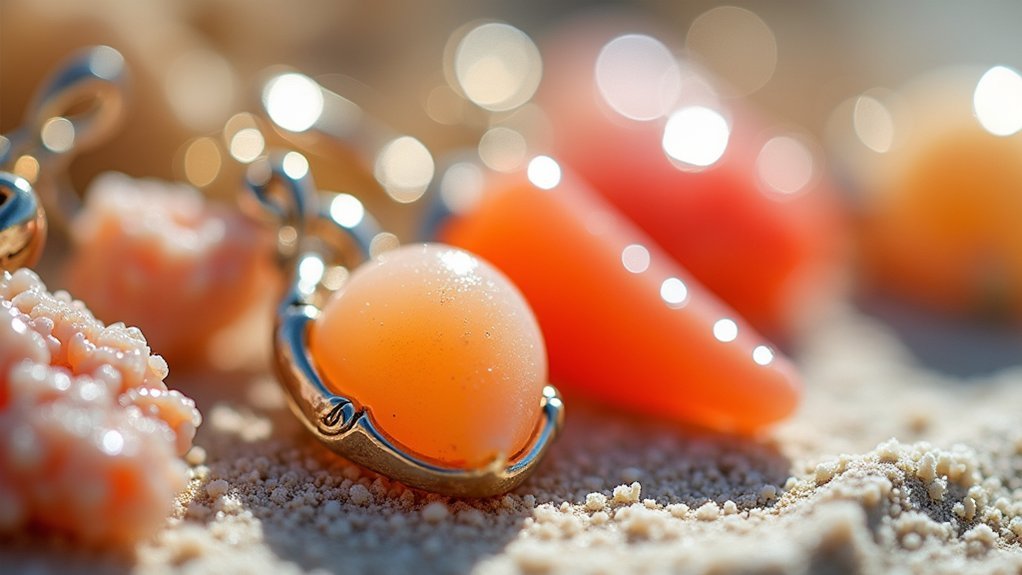You’ll preserve your turquoise stones by selecting natural waxes over petroleum-based ones, which create protective barriers without compromising stone integrity. Apply Renaissance Wax with gentle circular motions on clean, oil-free surfaces, then allow proper drying before buffing with a soft cloth. Maintain your waxed pieces by storing them in cool, dry locations away from direct sunlight and cleaning only with dry cloths. Master these fundamentals to access advanced preservation techniques that’ll keep your collection pristine.
Understanding Wax Types and Their Effects on Turquoise Stones

Wax selection plays a fundamental role in turquoise preservation, as different formulations can either protect or damage these delicate stones.
You’ll encounter petroleum-based options like Renaissance Wax and Johnson’s wax, which enhance appearance but introduce harmful substances over time. Natural waxes offer safer alternatives, creating protective barriers against moisture and environmental fading without compromising stone integrity.
Lower grade turquoise requires extra caution since porous stones trap oils and dirt when waxed, accelerating deterioration.
You should avoid harsh chemicals entirely and test any wax on inconspicuous areas first. Proper care involves understanding your stone’s porosity level before applying anything.
Consider alternative cleaning practices like gentle dusting with wax paper for routine maintenance, as excessive wax buildup obscures natural beauty and texture.
Proper Application Techniques for Protective Wax Coatings
Once you’ve selected the appropriate wax for your turquoise, mastering proper application techniques becomes your next priority.
Start by ensuring your turquoise jewelry surface is completely clean and oil-free for ideal protective coating adhesion. Apply a small amount of Renaissance Wax using a soft cloth in circular motions, distributing evenly without excessive pressure that could damage the porous structure.
Clean turquoise thoroughly before applying Renaissance Wax in gentle circular motions to avoid damaging the porous stone structure.
Allow the wax to dry according to manufacturer instructions before buffing gently with a clean cloth for a superior polishing finish. Schedule regular maintenance every few months when surfaces appear dull to maintain protection and luster.
Always avoid waxes containing harsh solvents that can compromise your clean turquoise’s structural integrity over time.
Long-Term Maintenance After Wax Treatment Application

After completing your wax application, proper long-term maintenance guarantees your turquoise retains its protective barrier and lustrous appearance for years to come.
Allow your turquoise items to cure for 24 hours before handling. Store your treated pieces in cool, dry locations away from direct sunlight to prevent wax degradation from temperature changes.
Clean waxed surfaces using only soft, dry cloths—never harsh chemicals or detergents that’ll break down the protective coating. After washing hands or handling other materials, verify they’re completely dry before touching your turquoise.
Regularly inspect for wear signs and reapply wax treatment when the surface appears dull. Proper storing turquoise practices combined with gentle maintenance routines will maximize your wax treatment’s effectiveness and preserve your stones’ natural beauty.
Frequently Asked Questions
How Do You Preserve Turquoise?
You’ll preserve turquoise by avoiding wax treatments, cleaning gently with damp cloth, storing in cool dry places, limiting chemical exposure, and seeking professional jeweler assessments for repairs when needed.
What Is Used to Stabilize Turquoise?
You’ll use clear resins or polymers to stabilize turquoise, with epoxy resins being most common. These treatments penetrate the stone, increasing hardness and durability while preventing chipping and cracking during wear.
Does Sleeping Beauty Turquoise Need to Be Stabilized?
You’ll find Sleeping Beauty turquoise sometimes needs stabilization despite its natural durability. While it’s less porous than other varieties, some pieces still benefit from resin treatment to prevent chipping and enhance structural integrity.
How to Enhance Turquoise?
You can enhance turquoise by applying gemstone-specific wax in thin layers using soft cloth. This protects against moisture, seals surface flaws, and maintains vibrant color while preserving the stone’s natural beauty.
In Summary
You’ve now got the knowledge to protect your turquoise stones effectively through proper waxing. Remember to choose the right wax type for your specific stone, apply it using gentle, consistent techniques, and don’t neglect regular maintenance checks. Your turquoise’s vibrant color and natural beauty will last for years when you follow these preservation methods. Take your time with each step, and you’ll see excellent results that’ll keep your stones looking their absolute best.




Leave a Reply